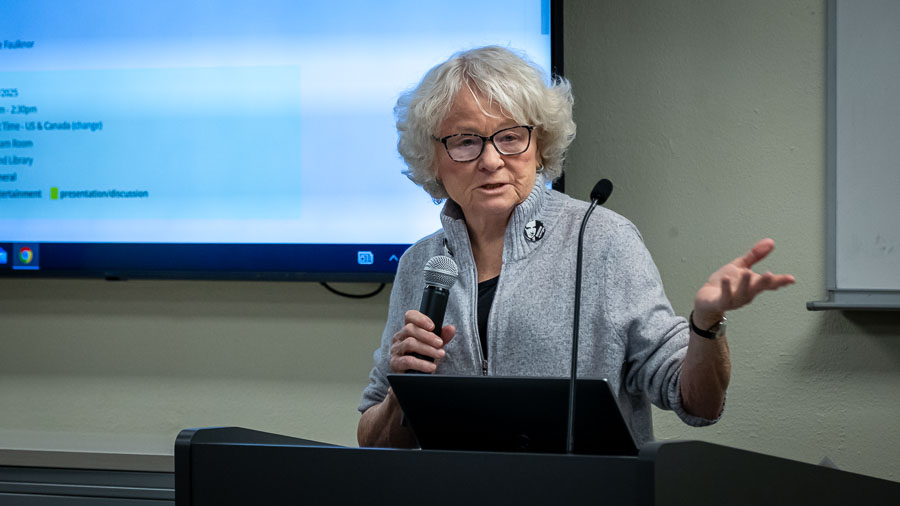Gearhart Mountain: Burned and scarred by the Bootleg Fire, but still beautiful
Published 10:30 am Tuesday, August 15, 2023

- A badly burned tree stands near the Palisades.
GEARHART MOUNTAIN WILDERNESS AREA — Large sections are burned and scarred, but many sections of the Gearhart Mountain Wilderness Area remain ruggedly beautiful.
During a hike into the Palisades region of the Gearhart, Anthony Benedetti, the Fremont-Winema National Forest’s recreation operations specialist who oversees 100 miles of trails in wilderness areas, checked out lingering damage from the 2021 Bootleg Fire. The blaze burned 413,765 acres in Klamath and Lake counties, including vast tracts of land within the 22,684-acre Gearhart. Forest officials say large segments of the wilderness had a tree mortality of 91% or greater.
Two years later, damage from the Bootleg Fire is starkly visible. The three trailheads that provide access to the Gearhart — Deming Creek, Lookout Rock and the North Fork Sprague — were closed by the fire. Although the North Fork Sprague reopened earlier this summer. the Deming Creek and Lookout Rock trailheads “will remain closed until further notice,” according to the forest’s website. Along with downed trees, the site notes, “the trail tread is difficult to find in multiple locations.”
The Lookout Rock Trailhead closure is significant because it provides the easiest access to the frequently visited Palisade Rocks, an intriguing area of geological interest. The trailhead is located a mile past the Corral Creek Campground. From there, it’s a mile to the Palisades network of volcanic rock spires, towers and balancing rocks. The Palisades is an area of wonder and fascination.
Benedetti, who credits volunteers from the Northwest Youth Corps and the High Desert Trails Riders for restoring the tread work and clearing trees to reopen the North Fork Sprague, he has hiked into the wilderness from the Deming Creek Trailhead, which is often used by equestrians. Following a recent visit, he believes considerable work, including repairing the trail tread, will be required.
Because of ongoing work to open trails in the Forest’s three other wilderness areas — Sky Lakes, Mountain Lakes and Mount Thielsen — until last week Benedetti had not hiked into the Gearhart from the Lookout Rock Trailhead this summer.
The hike from Corral Creek to and into the Gearhart — the road to the trailhead is closed at the Corral Creek Campground — passes through severely burned areas. Although a portion of the road has been cleared, a large section is flanked by blackened trees that pose a danger of falling and blocking the road.
Eerie remnants of the fire include “catface trees” which have odd wounds and vertical scars on tree trunks caused by intensive forest fires. Catfaces are partially healed or grown-over wounds created, according to Forestryforum.com, “from successive ridges of callous tissue forming as the tree attempts to close the wound opening.”
Along the road to the trailhead and in the wilderness, the size of catfaces, which do not appear like the faces of cats, ranged from narrow openings to others large enough to stand inside. In some instances, the insides of the trees appeared carved or gutted out. Catface trees, Benedetti said, can pose a danger because they are suspectable to bugs and decay that can result in them falling and crashing.
The trailhead sign by the closed parking is partially burned, with only the words “trail h…” remaining. Not found, however, was the “Gearhart Wilderness” sign.
The trail to the Palisades was littered with fallen, fire-blackened trees. Endless rows of roasted, branchless trees, some looking like badly burnt toast, spread across what had been green forestlands. Along the way and in the wilderness, varieties of flowers added welcome outbursts of color to the otherwise bleak blackness. Most notable is the appropriately named fireweed. The purplish, showy flower earned its name because it is the first to appear after forest fires.
Happily, the Palisades appear unaffected by the fire. Although there were concerns the rock faces might be scorched, we — including Fremont-Winema public affairs officer Benjamin Wilson — saw no visual evidence.
Evidence of the fire persisted beyond the Palisades, with some fallen trees blocking sections of the 13-mile-long Gearhart Mountain Trail. Fewer trees were completely fried, although several Ponderosa pines, known as being fire resistant, had portions of their bark, usually from the ground up, blackened. Because of limitations in wilderness areas, logging is not permitted. Hand tools, such as crosscut saws, can be used but chainsaws are not allowed.
We turned around before reaching the junction with the Deming Creek Trail, which Benedetti and Nate Crabtree recently flagged, which will help trail crews find their way while working on the trail. “It will be a lot of work to complete this project,” Benedetti said of reopening the Deming Creek Trail.
As evidenced from our outing, when the Lookout Point Trail will reopen is also uncertain. The Fremont-Winema currently has no dedicated trail crews. And, because of the recent Sunset Fire and the possibility of other forest fires this year, it’s possible that Forest personnel will be diverted elsewhere.
Benedetti, who has worked on the Fremont-Winema the past eight years and is credited for overseeing and working to open formerly closed wilderness trails, is transferring to a similar job in Idaho. The Forest is currently recruiting for a replacement. Although the outing was mainly to view damage along the Lookout Point Trail, Benedetti carried and used a saw to clear a section of trail that had disappeared under a barrage of fallen trees.
He also expressed concern that runoff from melting snow and rain will require extensive efforts to widen sections of semi-washed-out trail.
When the remaining two access trails to the Gearhart will reopen is unknown. Ben Goodin, district ranger for the Lakeview Ranger District, noted, “Lookout Rock and Deming Creek trails are still closed to the public until hazard tree abatement can be completed. We are working as quickly, safely and efficiently as possible to remove hazard trees and ensure public safety and the safety of our workforce.”










